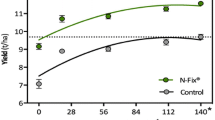Abstract
Bacteria causing mottled stripe disease in sugar cane, known asPseudomonas rubrisubalbicans, were shown to be able to fix molecular N2 and to grow on it. The root associated diazotroph known asHerbaspirillum seropedicae, after artificial inoculation caused mottled stripe disease symptoms on sorghum and Napier grass but not on sugar cane. Both bacteria could be reisolated from leaves even 60 days after. Sugar cane leaves contained large numbers of these bacteria even in the uninoculated controls. Additional physiological characteristics of six strains ofP. rubrisubalbicans were compared with those of twoH. seropedicae strains and were shown to be very similar.
Similar content being viewed by others
References
Baldani J I, Baldani V L D, Sampaio M J A M and Döbereiner J 1984 A fourthAzospirillum species from cereal roots. An. Acad. Bras. Cien. 56, 365.
Baldani J I, Baldani V L D Seldin L and Döbereiner J 1986 Characterization ofHerbaspirillum seropedicae gen. nov., sp. nov., a root associated nitrogen-fixing bacterium. Inter. J. Syst. Bacteriol. 36, 86–93.
Edgerton C W 1955 Sugar Cane and its Diseases. Louisiana State University Press, Baton Rouge, LA.
Fu A H and Burris R H 1989 Ammonium inhibition of nitrogenase activity inHerbaspirillum seropedicae. J. Bacteriol. 171, 3168–3175.
Galli F, Carvalho P C T, Tokeshi H, Balmer F, Kimati H, Cardoso C O, Salgado C L, Krugner T L, Cardoso E J B N and Bergamin F A 1980 Manual de Fitopatologia: Doenças das plantas cultivadas. Ed. Agronômica Ceres, 2a ed, vol 2. Såo Paulo, Brazil.
Goor M, Falsen E, Pot B, Gillis M, Kersters K and De-Ley J 1986 Taxonomic position of the phytopathogenPseudomonas rubrisubalbicans and related clinical isolates. XIV Int. Congr. Microbiol. Wanchester, England (Abstract).
Hale C N and Wilke J P 1972a A comparative study ofPseudomonas species pathogenic to sorghum. N.Z.J. Agric. Res. 15, 448–456.
Hale C N and Wilke J P 1972b Bacterial leaf stripe of sorghum in New Zealand, N.Z. J. Agric. Res. 15, 457–460.
Kanvinde U and Sastry G R R 1990Agrobacterium tumefaciens is a diazotrophic bacterium. Appl. Environ. Microbiol. 56, 2087–2092.
Palleroni J N 1984 Family I. Pseudomonadaceae.In Bergey's Manual of Systematic Bacteriology. vol 1. Eds. N RKrieg and J GHolt. pp 141–199. Williams & Wilkins Co., Baltimore, MD.
Tarrand J J, Krieg N R and Döbereiner J 1978 A taxonomic study of theSpirillum lipoferum group, with descriptions of a new genus.Azospirillum lipoferum (Beijerinck) comb. nov. andAzospirillum brasilense sp. nov Can. J. Microbiol. 24, 967–980.
Watanabe I, So R, Ladha J K, Katayama-Fujimura Y and Kuraish H 1987 A new nitrogen-fixing species of Pseudomonas:Pseudomonas diazotrophicus sp. nov. isolated from the root of wetland rice Can. J. Microbiol. 33, 670–678.
Author information
Authors and Affiliations
Rights and permissions
About this article
Cite this article
Pimentel, J.P., Olivares, F., Pitard, R.M. et al. Dinitrogen fixation and infection of grass leaves byPseudomonas rubrisubalbicans andHerbaspirillum seropedicae . Plant Soil 137, 61–65 (1991). https://doi.org/10.1007/BF02187433
Issue Date:
DOI: https://doi.org/10.1007/BF02187433




